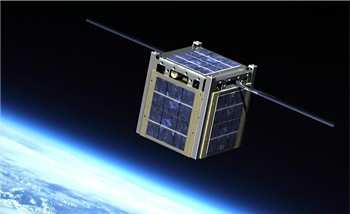Mon, Jul 15, 2013
Three Micro-Thruster Technologies Determined To Have Potential
NASA selected three proposals for the development of lightweight micro-thruster propulsion technologies that are small in size but have big potential. NASA's Space Technology Mission Directorate selected the miniaturized electrospray propulsion technologies to perform stabilization, station keeping and pointing for small spacecraft. NASA hopes these technology demonstrations may lead to similar position control systems for larger spacecraft and satellites as well.

NASA's Game Changing Development Program, managed by the agency's Langley Research Center in Hampton, Va., sponsored this solicitation and will oversee the first phase of this technology development.
The three awards selected for contract negotiations are:
- 'Microfluidic Electrospray Propulsion (MEP)' by NASA's Jet Propulsion Laboratory, Pasadena, CA.
- Miniature ElectroSpray Thrusters Based on Porous Surface Emission' by Busek Company, Inc., Natick, MA.
- 'Scalable ion Electrospray Propulsion System (S-iEPS)' by the Massachusetts Institute of Technology (MIT), Cambridge, MA.
Proposals for this solicitation were received from NASA centers, federally funded research and development centers, universities and industry. At least one electrospray technology will be selected for further development as an in-space flight demonstration through NASA's Small Spacecraft Technology Program during Phase II, which will be made through a separate solicitation.

One of NASA's priorities is to seek and develop new technologies that will radically change the capabilities for small satellites. There currently is a lack of efficient propulsion for a class of low cost, nanosatellite research spacecraft called "Cubesats," which measure about 4 inches on each side and weigh less than 3 pounds. The successful development and demonstration of these miniaturized systems will offer low mass, low-power propulsion for these small spacecraft and potentially revolutionize the future of Cubesats.
Miniaturized electrospray propulsion technologies also signal a revolutionary alternative for position control systems for larger satellites. Several studies have shown that micro-thrusters could replace currently accepted systems on large spacecraft, saving weight and space while significantly increasing mission reliability and lifetimes. This technology also could enable other game changing propulsion capabilities from micro-scale to large, deployable spacecraft structures.
More News
"Fly-by-wire flight, coupled with additional capability that are being integrated into ALFA, provide a great foundation for Bell to expand on its autonomous capabilities. This airc>[...]
Hold Procedure A predetermined maneuver which keeps aircraft within a specified airspace while awaiting further clearance from air traffic control. Also used during ground operatio>[...]
Aero Linx: B-21 Raider The B-21 Raider will be a dual-capable penetrating strike stealth bomber capable of delivering both conventional and nuclear munitions. The B-21 will form th>[...]
Also: Virgin Galactic, B-29 Doc to Allentown, Erickson Fire-Fighters Bought, FAA Reauthorization After dealing with a big letdown after the unexpected decision by Skyreach to disco>[...]
Also: Skydio Chief, Uncle Sam Sues, Dash 7 magniX, OR UAS Accelerator US Secretary of the Air Force Frank Kendall was given a turn around the patch in the 'X-62A Variable In-flight>[...]
 Aero-News: Quote of the Day (05.09.24)
Aero-News: Quote of the Day (05.09.24) ANN's Daily Aero-Term (05.09.24): Hold Procedure
ANN's Daily Aero-Term (05.09.24): Hold Procedure ANN's Daily Aero-Linx (05.09.24)
ANN's Daily Aero-Linx (05.09.24) Airborne 05.03.24: Advanced Powerplant Solutions, PRA Runway Woes, Drone Racing
Airborne 05.03.24: Advanced Powerplant Solutions, PRA Runway Woes, Drone Racing Airborne-NextGen 05.07.24: AI-Piloted F-16, AgEagle, 1st 2 WorldView Sats
Airborne-NextGen 05.07.24: AI-Piloted F-16, AgEagle, 1st 2 WorldView Sats




